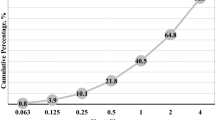Abstract
This study falls within a global approach aiming to preserve the environment on the one hand and to valorize high-density polyethylene (HDPE) plastic waste on the other hand. The aim is to study the possibility of using HDPE particles as a sand substitute in the manufacturing of geopolymer mortars based on an industrial sludge. A structural, mineralogical and mechanical study was carried out on the control mortar (without plastic) and mortars with different percentages of plastic waste. The DRX spectra of the industrial sludge used as a precursor of geopolymer materials shows the presence of two crystalline phases (Quartz, muscovite). After the geopolymerization reaction, no other crystalline phases are formed in all DRX spectra of geopolymeric mortars prepared on the basis of calcined industrial sludge, sand and HDPE plastic. The Raman spectra of geopolymeric mortars show the presence of several geopolymeric phases. The compressive and flexural strength of mortars increases with the increase of the percentage of HDPE aggregates as a substitute for sand compared to sand-based geopolymer mortars. Geopolymer mortars made from the plastic waste replacing sand have a higher mechanical performance than sand-based mortars. All these results lead to the conclusion that the plastic waste can be a potential source of raw material for the manufacturing of geopolymer mortars.
Access this chapter
Tax calculation will be finalised at checkout
Purchases are for personal use only
Similar content being viewed by others
References
“Compressive Strength of Concrete, Cube Test, Procedure, Results & FAQ,” CIVIL READ, 18 May 2018. https://civilread.com/compressive-strength-of-concrete-test/. Accessed 20 Jul 2020
Lamrani, S., Allal, L.B., Ammari, M.: Valorization of an industrial waste (sludge) as an artificial pozzolan in cementitious materials. Int. J. Eng. Res. Appl. 6(12), 13 (2016)
NF ISO 11464 - Décembre 2006. https://www.boutique.afnor.org/norme/nf-iso-11464/qualite-du-sol-pretraitement-des-echantillons-pour-analyses-physico-chimiques/article/641815/fa134263. Accessed 24 Jul 2020
Chuah, S., et al.: The properties of fly ash based geopolymer mortars made with dune sand. Mater. Des. 92, 571–578 (2016). https://doi.org/10.1016/j.matdes.2015.12.070
Arellano-Aguilar, R., Burciaga-Díaz, O., Gorokhovsky, A., Escalante-García, J.: Geopolymer mortars based on a low grade metakaolin: effects of the chemical composition, temperature and aggregate: binder ratio. Constr. Build. Mater. 50, 642–648 (2014). https://doi.org/10.1016/j.conbuildmat.2013.10.023
Wei, X., Ming, F., Li, D., Chen, L., Liu, Y.: Influence of water content on mechanical strength and microstructure of alkali-activated fly ash/GGBFS mortars cured at cold and Polar regions. Materials (Basel) 13(1), 138 (2019). https://doi.org/10.3390/ma13010138
M’sadak, Y., M’barek, A.B.: Valorisations environnementale, énergétique et agronomique de la biométhanisation industrielle appliquée à la biomasse avicole récupérée en Tunisie. Revue Marocaine des Sciences Agronomiques et Vétérinaires 3(3), 54–66 (2015)
Sata, V., Sathonsaowaphak, A., Chindaprasirt, P.: Resistance of lignite bottom ash geopolymer mortar to sulfate and sulfuric acid attack. Cement Concr. Compos. 34(5), 700–708 (2012). https://doi.org/10.1016/j.cemconcomp.2012.01.010
Ghosh, S.: Acid resistance of fly ash based Geopolymer mortars. Accessed 29 Feb 2020. https://www.academia.edu/2642787/Acid_Resistance_of_Fly_ash_based_Geopolymer_mortars
Alkan, C., Sari, A.: Fatty acid/poly (methyl methacrylate) (PMMA) blends as form-stable phase change materials for latent heat thermal energy storage. Sol. Energy 82(2), 118–124 (2008). https://doi.org/10.1016/j.solener.2007.07.001
Cabrera-Covarrubias, F.G., Arredondo-Rea, S.P., Gómez-Soberón, J.M., Almaral-Sánchez, J.L., Corral-Higuera, R.: Mechanical properties of mortars containing recycled ceramic as a fine aggregate replacement. Revista de la construcción 14(3), 22–29 (2015). https://doi.org/10.4067/S0718-915X2015000300003
Resistance to acid attack, abrasion and leaching behavior of alkali-activated mine waste binders. https://springerlink.bibliotecabuap.elogim.com/article/10.1617/s11527-010-9643-3?shared-article-renderer. Accessed 29 Feb 2020
Allahverdi, A., Škvára, F.: SULFURIC acid attack on hardened paste of Geopolymer cements part 2. Corrosion mechanism at mild and relatively low concentrations, p. 4 (2006)
NF EN 196–1 - Septembre 2016. https://www.boutique.afnor.org/norme/nf-en-196-1/methodes-d-essais-des-ciments-partie-1-determination-des-resistances/article/866862/fa184622. Accessed 24 Jul 2020
Morrell, R.: Measurement Good Practice Guide, no. 7, p. 74
Author information
Authors and Affiliations
Editor information
Editors and Affiliations
Rights and permissions
Copyright information
© 2022 The Author(s), under exclusive license to Springer Nature Switzerland AG
About this paper
Cite this paper
Jeniah, H., El Ayadi, H., Belmokhtar, N., Ammari, M., Ben Allal, L. (2022). Development of a New Waste Valorisation Process: A Case Study. In: Kacprzyk, J., Balas, V.E., Ezziyyani, M. (eds) Advanced Intelligent Systems for Sustainable Development (AI2SD’2020). AI2SD 2020. Advances in Intelligent Systems and Computing, vol 1417. Springer, Cham. https://doi.org/10.1007/978-3-030-90633-7_28
Download citation
DOI: https://doi.org/10.1007/978-3-030-90633-7_28
Published:
Publisher Name: Springer, Cham
Print ISBN: 978-3-030-90632-0
Online ISBN: 978-3-030-90633-7
eBook Packages: Intelligent Technologies and RoboticsIntelligent Technologies and Robotics (R0)




